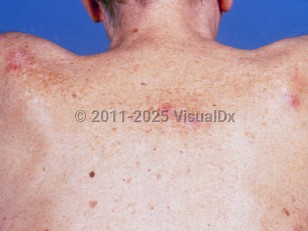Chronic lymphocytic leukemia
Alerts and Notices
Important News & Links
Synopsis

Chronic lymphocytic leukemia (CLL) is a hematologic neoplasm characterized by an overproduction of mature, monoclonal B lymphocytes. The term CLL is used when the disease is predominantly in the peripheral blood, while the term small lymphocytic lymphoma (SLL) is used when the disease is mostly in lymph nodes. They are identical in pathologic and immunophenotypic characteristics.
CLL is the most common form of adult-onset leukemia in Western countries and comprises approximately one-quarter to one-third of all leukemias in the United States. The majority of CLL cases occur in older adults of Northern European descent (older than 55 years) and in elderly patients. The median age at diagnosis is 70 years; however, it can occur in younger patients as well. Male-to-female ratio is approximately 1.7-2:1. Overall in the United States, approximately 16 000 new CLL cases are reported annually. The incidence of CLL / SLL differs by race and geographic location. For example, in the United States, incidence is higher in people of Northern European descent as compared to African American or Asian Pacific Islander descent.
CLL is a heterogeneous disease with some patients experiencing indolent clinical courses that may not require treatment and other patients experiencing active disease or progressive disease. Treatment is indicated for patients with evidence of bone marrow failure, massive or progressive splenomegaly, massive or progressive lymphadenopathy, symptoms of extranodal involvement, constitutional symptoms, or progressive lymphocytosis (monitored by the "lymphocyte doubling time"). Some patients may have renal complications. Treatment and management depend largely on staging / signs of disease progression.
Cutaneous findings in CLL: Leukemia cutis is a rare manifestation of CLL. Eosinophilic dermatosis of hematologic malignancy (EDHM, formerly termed insect bite-like reaction) is a pruritic eruption that is also rare; however, CLL is the most commonly associated hematologic malignancy. An increased risk of nonmelanoma skin cancers has been noted in patients with CLL, especially those who are older than 70 years and those who have received prior chemotherapy. Additionally, an increased incidence of melanoma, Merkel cell carcinoma, dermatofibrosarcoma protuberans, and other rare skin cancers has been reported.
CLL is the most common form of adult-onset leukemia in Western countries and comprises approximately one-quarter to one-third of all leukemias in the United States. The majority of CLL cases occur in older adults of Northern European descent (older than 55 years) and in elderly patients. The median age at diagnosis is 70 years; however, it can occur in younger patients as well. Male-to-female ratio is approximately 1.7-2:1. Overall in the United States, approximately 16 000 new CLL cases are reported annually. The incidence of CLL / SLL differs by race and geographic location. For example, in the United States, incidence is higher in people of Northern European descent as compared to African American or Asian Pacific Islander descent.
CLL is a heterogeneous disease with some patients experiencing indolent clinical courses that may not require treatment and other patients experiencing active disease or progressive disease. Treatment is indicated for patients with evidence of bone marrow failure, massive or progressive splenomegaly, massive or progressive lymphadenopathy, symptoms of extranodal involvement, constitutional symptoms, or progressive lymphocytosis (monitored by the "lymphocyte doubling time"). Some patients may have renal complications. Treatment and management depend largely on staging / signs of disease progression.
Cutaneous findings in CLL: Leukemia cutis is a rare manifestation of CLL. Eosinophilic dermatosis of hematologic malignancy (EDHM, formerly termed insect bite-like reaction) is a pruritic eruption that is also rare; however, CLL is the most commonly associated hematologic malignancy. An increased risk of nonmelanoma skin cancers has been noted in patients with CLL, especially those who are older than 70 years and those who have received prior chemotherapy. Additionally, an increased incidence of melanoma, Merkel cell carcinoma, dermatofibrosarcoma protuberans, and other rare skin cancers has been reported.
Codes
ICD10CM:
C91.10 – Chronic lymphocytic leukemia of B-cell type not having achieved remission
SNOMEDCT:
51092000 – Chronic lymphocytic leukemia
C91.10 – Chronic lymphocytic leukemia of B-cell type not having achieved remission
SNOMEDCT:
51092000 – Chronic lymphocytic leukemia
Look For
Subscription Required
Diagnostic Pearls
Subscription Required
Differential Diagnosis & Pitfalls

To perform a comparison, select diagnoses from the classic differential
Subscription Required
Best Tests
Subscription Required
Management Pearls
Subscription Required
Therapy
Subscription Required
References
Subscription Required
Last Reviewed:12/09/2019
Last Updated:02/08/2023
Last Updated:02/08/2023
Chronic lymphocytic leukemia

